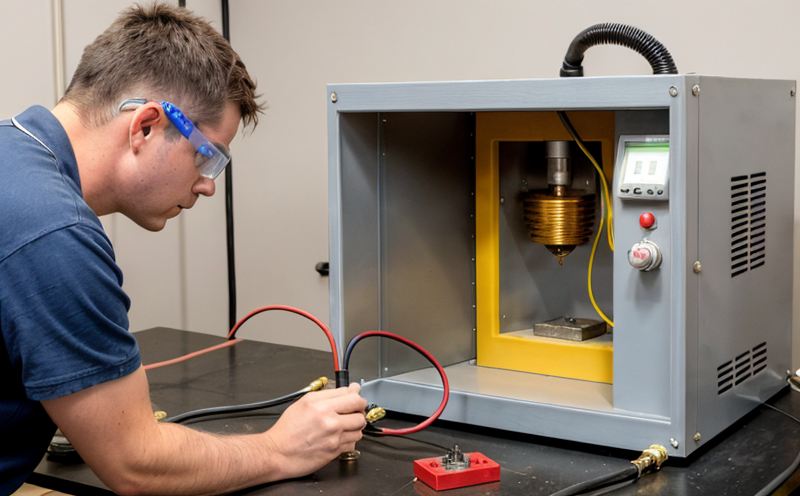ASTM B193 Electrical Conductivity of Conductors
The ASTM B193 standard is a critical tool used by metallurgists, material scientists, and engineers to measure the electrical conductivity of metallic conductors. This test is essential in ensuring that materials meet specified performance criteria, particularly in industries where conductor integrity and reliability are paramount.
The ASTM B193 method assesses the resistance of metals to electric current flow at a specific temperature. This measurement can vary significantly based on the material composition, purity, and heat treatment process. Conductors with higher electrical conductivity allow for more efficient power transmission without significant losses in energy during transport. Understanding these properties is crucial for industries such as aerospace, automotive, electronics, and construction.
The test procedure involves placing a sample of the conductor between two electrodes submerged in a liquid electrolyte solution. A constant current is passed through the sample, and the voltage drop across it is measured. The resistance (R) can then be calculated using Ohm's law: R = V/I, where V is the voltage across the conductor and I is the current passing through it. Finally, the electrical conductivity (σ) of the material is derived from its reciprocal:
\[ \sigma = \frac{1}{R} \]
This calculation provides a quantitative measure that reflects how well the material conducts electricity.
The ASTM B193 method is particularly useful for materials like copper, aluminum, and their alloys. These metals are widely used in electrical wiring, cables, and other conductive applications due to their excellent conductivity properties. The test helps ensure that products meet industry standards and customer expectations regarding performance and reliability.
| Sample Preparation | Measurement Conditions | Calculation Formula |
|---|---|---|
| Clean the sample thoroughly to remove any contaminants or oxides that could affect conductivity measurements. | Test at a standard temperature of 20°C ± 1°C with a constant current applied for a specified time. | \[ \sigma = \frac{I}{VR} \] |
The results obtained from the ASTM B193 test can be used to compare different materials or batches of material, ensuring consistency and quality. This standard is widely recognized in industries that rely heavily on electrical conductivity as a critical property for their products.
In conclusion, the ASTM B193 Electrical Conductivity of Conductors test provides valuable insights into the performance characteristics of metallic conductors. Its application ensures that materials used in manufacturing meet stringent quality standards and perform reliably under various conditions.
Why It Matters
The ASTM B193 test is essential for several reasons, particularly in sectors where electrical conductivity plays a crucial role. This includes aerospace, automotive, and electronics manufacturing, among others.
- Aerospace Industry: High conductive materials are vital for lightweight, durable, and efficient aircraft components. Ensuring that the metal used meets the required specifications is critical for safety and performance.
- Automotive Sector: The automotive industry demands reliable electrical connections to ensure safe operation of vehicles. Conductors with consistent properties contribute significantly to vehicle reliability and longevity.
- Electronics Manufacturing: In this sector, the quality of conductors directly impacts the efficiency and durability of electronic devices. Ensuring that materials meet ASTM B193 standards enhances product performance and extends their operational life.
The test also helps in compliance with international standards such as ISO, IEC, and EN, ensuring that products are up-to-date with global regulatory requirements.
By adhering to the ASTM B193 method, manufacturers can produce high-quality materials that meet customer expectations and industry benchmarks. This not only enhances product performance but also ensures long-term reliability and safety in critical applications.
Scope and Methodology
The ASTM B193 standard defines a comprehensive approach to determining the electrical conductivity of metallic conductors. The scope includes various types of metals and alloys that are commonly used in electrical applications.
| Scope | Methodology |
|---|---|
| The test applies to metallic materials that exhibit good electrical conductivity, such as copper, aluminum, and their alloys. | Specimens are prepared according to the ASTM B193 specifications. The resistance of the sample is measured using a constant current method in an electrolyte solution at 20°C ± 1°C. |
| The test can be used for quality control, research and development, and compliance with international standards. | Measurements are taken after allowing the specimen to stabilize for a specified period. The final conductivity value is reported in microsiemens per centimeter (μS/cm). |
The methodology outlined in ASTM B193 ensures that all measurements are consistent and reproducible, providing accurate data for decision-making purposes.
For detailed information on specimen preparation, equipment requirements, and sample conditions, please refer to the full ASTM B193 standard document. This resource provides a thorough guide for those conducting these tests in their laboratories or facilities.
Quality and Reliability Assurance
- The use of ASTM B193 ensures that all measurements are standardized, which is crucial for consistent quality across batches of materials. This standardization helps in identifying any deviations from expected performance early on.
- The test results can be used to compare different samples or suppliers, ensuring that the highest quality materials are selected for production. This not only enhances product reliability but also builds trust with customers and regulatory bodies.
Quality managers and compliance officers rely heavily on ASTM B193 to ensure that their products meet international standards and industry expectations. The test results provide a reliable measure of the electrical conductivity, which is essential for maintaining product integrity over time.
In addition to quality control, the ASTM B193 method plays a vital role in research and development efforts. Engineers can use this data to optimize material compositions and improve performance characteristics. This ensures that new products are developed with the highest standards of electrical conductivity, enhancing overall product reliability.





